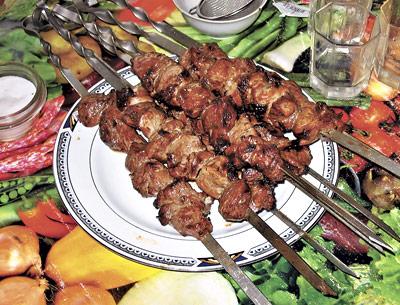Seasons by the Sea: A Taste of Sochi

What kinds of foods are our athletes, their families, and fans eating in Sochi at the 2014 Winter Olympics? Well, you needn’t fret over the nutritional needs of the United States ski team. They are not residing in the athlete’s village, but are in the mountains above Sochi cocooned in comfort with private chefs attending to their every culinary need. Almost. It actually appears that they are eating a lot of Asian-inspired meals full of rice noodles and fish sauce.
Let’s face it, while some Russian food can be delicious, it is generally very heavy due to long winters and a lack of fresh fruits and vegetables. The “Today” show recently offered a demonstration of some traditional Russian dishes — borscht, beef stroganoff served with either egg noodles, mashed potatoes, or white rice, and tartlets filled with jelly or lemon curd. This on the day that the show was promoting awareness of heart disease in women! But that wasn’t the worst of it. This belly bomb of a Russian meal was followed by a segment with Giada de Laurentis smilingly demonstrating crisped slices of salami to dip into sour cream as a fun and easy snack.
Maria Losyukova, a Sochi spokeswoman, told one newspaper that “borscht is just one example of Russian dishes that will be served in the Olympic park. Other classic dishes are pelmeni and shashlyk. Also traditional hot pastries, cakes, and blinis.” F.Y.I., pelmeni are dumplings filled with meat or fish, and shashlyk are like shish kebabs, i.e., more meat. They estimate that approximately 2.1 million meals will be served to volunteers and 70,000 gallons of borscht will be a part of those meals. And yes, there is a McDonald’s on site for those looking for the ghastly comfort of fast food from home.
On a website called “Way to Russia,” the need and necessity for highly caloric foods is explained. “The food should give us much energy and warmth to survive during the winter time. So essential components are the ones which provide more carbohydrates and fat rather than proteins. Fresh fruits and vegetables are rarely used in food. The top five components of a Russian meal are potatoes, eggs, bread, meat, and butter. Other popular foods are cabbage, milk, sour cream, curds, mushrooms, lard, cucumbers, honey, sugar, salt, garlic, and onions.” I didn’t know lard and salt and sugar are “foods.”
One popular dish found in many Russian restaurants and homes is a potato salad called Olivier, named after the Belgian chef who invented it. Tiny diced potatoes are combined with carrots, peas, and onions and bound with mayonnaise. Another dish, most common in Moscow restaurants, is zhulien, a casserole of mushrooms combined with sour cream and Emmentaler cheese. Blinis are divine, served as either a sweet dessert with cooked berries or as a savory topped with smoked salmon or caviar.
The vast differences between the food of the wealthy and of the poor are apparent in every country but are especially noticeable in Russia. For the less well off, the standard diet includes many sour and pickled items from cucumbers to beets to rye and dark wheat breads to kvass, the fermented beer-like drink made from black rye bread. Vegetable varieties are fundamental: cabbage, beets, and turnips. Onions, garlic, dill, and horseradish provide seasoning and curd cheese and sour cream the fat. Mongol conquerors get credit for introducing spices from Asia, and tea arrived in the late-17th century. Tsar Peter the Great gets credit for bringing a more European (mostly Scandinavian) flavor to the food of the wealthy. In the 19th century, French chefs flocked to St. Petersburg and Moscow.
The mushrooms of Russia deserve special attention, as it is a favorite pastime to forage for the many varieties. There is even a children’s marching song called “Panic Among the Mushrooms,” in which a general commands the mushrooms to go to war. The mushroom types are identified by their willingness to march to their deaths. The morels claim they are too elderly, but the gruzdi (probably milk caps) are brave and do battle. There are field mushrooms, morels, ink caps, chanterelles, boletus, and white boletus, which are similar to the cepes of Bordeaux.
Some members of the media at the Olympics have sent out some snarky tweets and pictures of the living conditions in Sochi; you have probably seen, heard, and read some of these. Shame on you, you little mushrooms, you are guests in this country! It won’t be long before you come home to grocery stores that offer anything you could possibly want to eat, fluffy down pillows, and clean water. In the meantime, I hope that the athletes from around the world and their families and guests will sample some of what Russia has to offer. It is a cuisine born of necessity, but served with pride.
Click for recipes
